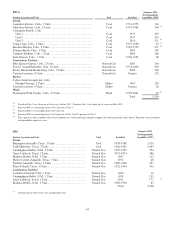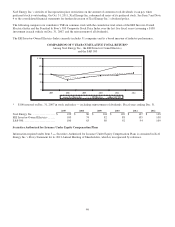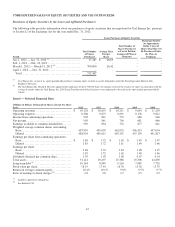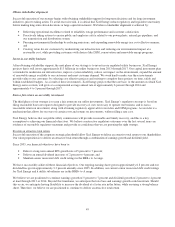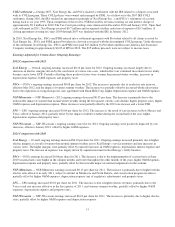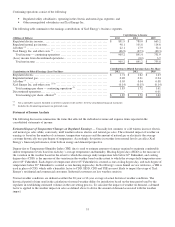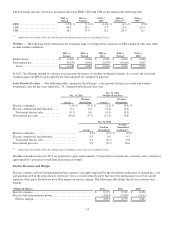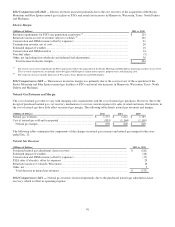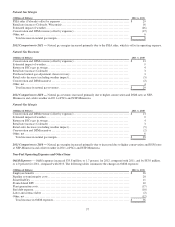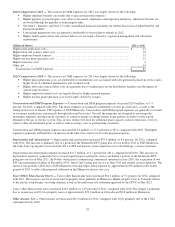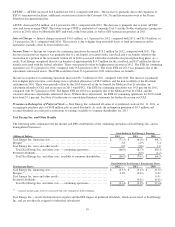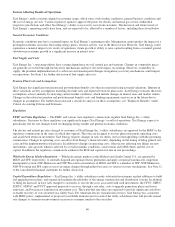Xcel Energy 2012 Annual Report Download - page 63
Download and view the complete annual report
Please find page 63 of the 2012 Xcel Energy annual report below. You can navigate through the pages in the report by either clicking on the pages listed below, or by using the keyword search tool below to find specific information within the annual report.
53
Continuing operations consist of the following:
• Regulated utility subsidiaries, operating in the electric and natural gas segments; and
• Other nonregulated subsidiaries and Xcel Energy Inc.
The following table summarizes the earnings contributions of Xcel Energy’s business segments.
Contributions to Income
(Millions of Dollars)
2012
2011
2010
Regulated electric income ....................................................
$
851.9
$
789.0
$
665.2
Regulated natural gas income.................................................
98.1
101.8
114.6
All other (a) .................................................................
22.1
17.9
32.4
Xcel Energy Inc. and other costs (a) ...........................................
(66.9
)
(67.3)
(60.3)
Total income — continuing operations ......................................
905.2
841.4
751.9
(Loss) income from discontinued operations ...................................
-
(0.2)
3.9
Total net income ..........................................................
$
905.2
$
841.2
$
755.8
Contributions to Diluted Earnings (Loss) Per Share
Contributions to Diluted Earnings (Loss) Per Share
2012
2011
2010
Regulated electric ...........................................................
$
1.74
$
1.62
$
1.43
Regulated natural gas ........................................................
0.20
0.21
0.24
All other (a) .................................................................
0.05
0.04
0.08
Xcel Energy Inc. and other costs (a) (b) .........................................
(0.14
)
(0.15)
(0.14)
Total earnings per share — continuing operations (b) .........................
1.85
1.72
1.61
Discontinued operations......................................................
-
-
0.01
Total earnings per share - diluted (b) ........................................
$
1.85
$
1.72
$
1.62
(a) Not a reportable segment. Included in all other segment results in Note 16 to the consolidated financial statements.
(b) Includes the dividend requirements on preferred stock.
Statement of Income Analysis
The following discussion summarizes the items that affected the individual revenue and expense items reported in the
consolidated statements of income.
Estimated Impact of Temperature Changes on Regulated Earnings — Unusually hot summers or cold winters increase electric
and natural gas sales while, conversely, mild weather reduces electric and natural gas sales. The estimated impact of weather on
earnings is based on the number of customers, temperature variances and the amount of natural gas or electricity the average
customer historically uses per degree of temperature. Accordingly, deviations in weather from normal levels can affect Xcel
Energy’s financial performance, from both an energy and demand perspective.
Degree-day or Temperature-Humidity Index (THI) data is used to estimate amounts of energy required to maintain comfortable
indoor temperature levels based on each day’s average temperature and humidity. Heating degree-days (HDD) is the measure of
the variation in the weather based on the extent to which the average daily temperature falls below 65° Fahrenheit, and cooling
degree-days (CDD) is the measure of the variation in the weather based on the extent to which the average daily temperature rises
above 65° Fahrenheit. Each degree of temperature above 65° Fahrenheit is counted as one cooling degree-day, and each degree of
temperature below 65° Fahrenheit is counted as one heating degree-day. In Xcel Energy’s more humid service territories, a THI is
used in place of CDD, which adds a humidity factor to CDD. HDD, CDD and THI are most likely to impact the usage of Xcel
Energy’s residential and commercial customers. Industrial customers are less weather sensitive.
Normal weather conditions are defined as either the 20-year or 30-year average of actual historical weather conditions. The
historical period of time used in the calculation of normal weather differs by jurisdiction based on the time period used by the
regulator in establishing estimated volumes in the rate setting process. To calculate the impact of weather on demand, a demand
factor is applied to the weather impact on sales as defined above to derive the amount of demand associated with the weather
impact.



